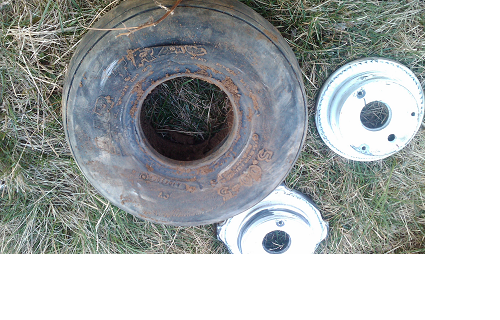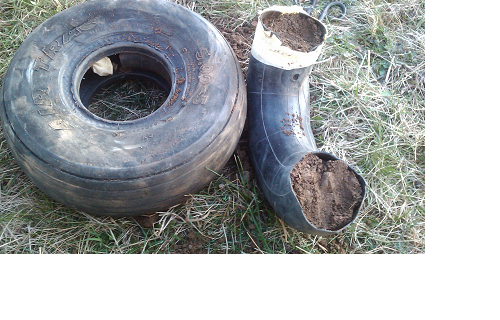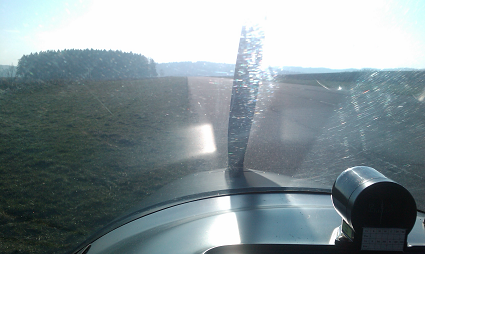The weather can sometimes get quite intense and unpredictable.
On one hard safety landing in a very turbulent environment and strong gusty winds, after intense runway braking before an obstacle, I discovered a puncture on the main gear wheel. Upon stopping and subsequent inspection, I found the right side tire casing punctured and at the same time punctured in one spot on the perimeter of the course with a subsequent blown tube.
How a sidewall cut and a puncture could occur on the same tire at the same time is not entirely clear to me...
The smaller, originally powder coating area I was in was far from civilization with a tire shop. The tube could not be patched though, the damage was too extensive. Plus, as it happens, it was Friday before dark...
I had a weak signal on my cell phone and my cell phone was almost dead. I tried to call companies that could still work and have the required tyres and tubes - to no avail. Even when I called the technicians' private phone numbers after hours, they told me that they did not have tires or tubes in stock. They claimed that they import tires and tubes from the USA. The nearest dealer for the type, AIR TRAC 5.00x5 aircraft tire with the correct weight is in England.

I was wondering how I could replace the 5.00x5 tire and inner tube with something... Ordering the correct inner tubes and tires would ground me for three weeks before the required items would arrive from the US. It would be possible to get the material sooner, in about five days, but the shipping cost and thus the price of the tire would increase disproportionately. There is also a replacement from Goodyear, but it is about 500-600g heavier per wheel. These replacements, twice as expensive, are available in Prague from...
"Beep beep", the phone says it's switching off, out of juice. I can't get help. In the current situation, the information from the technicians made it clear to me that everything will remain, as usual, on my improvisation. It's a good thing that I have some tools with me, although they are minimal, but I'll manage somehow. You wouldn't believe what can be done with a combination box, screwdriver and Allen key. I also found a piece of wire, a nail and a rusty pair of scissors at a nearby construction site.
A cut in the casing in the area of the letters RAC
It was getting dark and I knew I would have to spend the night by the plane, so that some intruder wouldn't take it apart... I'll continue in the morning with a cool head... I had no idea how literally, I woke up cold several times during the night, the sub-zero temperatures at night gave me what for. A strong cold front was reported for the following morning. It was necessary to get away as soon as possible after dawn.
It's safe to say that for at least half the night, thanks to the cold not allowing me to get a good night's sleep, I was able to discuss repair options:
I could have dismantled the plane and transported it on a sleeper - that's really what anyone can order... and the price.... Also, does it take at least 4-5 hours to disassemble a Tecnam P 2002 Sierra without tools? Especially how do you call for help without a phone? Rejected. One would think there must be something like a yellow angel that will change the wheel and that's it.
But that's not really how it works in small flying.
Or how about borrowing a spare wheel from someone who has the same type of plane and the same type of disc... but who's gonna lend it to me on a Saturday morning? Again, I'd need a charged cell phone.
I had the idea earlier in the evening that I could fill the inner tube with something on departure from a deserted airport, and put the tube, rotated against the tire, into the punctured and punctured tire, at least so that I could take off and the brake disc couldn't hit the ground. Easier would be to remove the brake disc, but then I wouldn't be able to land safely on a wet short of any other surface at my house.
The only suitable and available material was dirt in a field near the airport. I could stuff the inner tube with this to make it last for take off and landing and to give it the least rolling resistance !
In the morning, long before sunrise, after removing the brake disc from the wheel carriers and removing and disassembling the wheel from the plane, I started stuffing the unfrozen dirt into the inner tube, through the slightly enlarged puncture hole. To get to the right soft material, it was necessary to break up the frozen crust of soil. Once I had stuffed the inner tube nicely and compacted the dirt in it, I found that I didn't have the strength or skill to stuff it all the way into the shell with my chilled fingers. I decided to cut the soul in half right at the point of the puncture and against it.
Soul cut in half, half already in place, the other half still waiting to be assembled.
After some effort, I managed to insert both crescents of the cut in half, filled with clay, into the casing so that the punctured piece of the casing covered the soul. I also carefully filled the joints between the two crescents of the inner tube with clay. Once the wheel was assembled and mounted on the airplane, it was clear that the stuffed wheel would have dramatically increased rolling resistance.
In the morning, long before sunrise, after removing the brake disc from the wheel carriers and removing and disassembling the wheel from the plane, I started stuffing the unfrozen dirt into the inner tube, through the slightly enlarged puncture hole. To get to the right soft material, it was necessary to break up the frozen crust of soil. Once I had stuffed the inner tube nicely and compacted the dirt in it, I found that I didn't have the strength or skill to stuff it all the way into the shell with my chilled fingers. I decided to cut the soul in half right at the point of the puncture and against it.

Soul cut in half, half already in place, the other half still waiting to be assembled.
After some effort, I managed to insert both crescents of the cut in half, filled with clay, into the casing so that the punctured piece of the casing covered the soul. I also carefully filled the joints between the two crescents of the inner tube with clay. Once the wheel was assembled and mounted on the airplane, it was clear that the stuffed wheel would have dramatically increased rolling resistance. The aircraft would turn to the side of the cracked wheel on takeoff and landing. Fortunately it was the wheel on the right side, if the punctured wheel had been on the left side, the wheels may have needed to be swapped due to the reaction moment from the powerplant. The outboard right-hand drive R 912ULS engine, together with the SR 2000 three-blade in-flight adjustable propeller, promised plenty of power for this unusual operation.
As a precaution, to minimize the risk of spinning on takeoff, I positioned the aircraft so that the under-inflated wheel would take off from the tarmac and the second tire was dropped accordingly, leaving the takeoff wheel on the edge of the RWY where the grass surface was.
Takeoff from the runway edge

I lightened the aircraft by unloading everything I didn't need and didn't even have to drop fuel as there was just enough left in the tanks for the return plus a navigation reserve. I took off with the plane on the border between the grass and the tarmac. After a short rollout, on 30 degree flaps, which had to be corrected with foot control, I managed to pull the aircraft away and accelerate in a ground effect rollout. The flight over the target airport was uneventful. Before landing, it was clear that I had to sit on the minimum speed side of the functional wheel. I needed to do all of this far enough left of the runway centerline to allow room to correct for the turning caused by the greater rolling resistance of the right wheel. As I thought, so I did... In the end I managed to land at 150m, as usual. Surprisingly, the plane didn't get too hot.
So I was able to clean up the plane and drive over Monday morning to get new air certified tires with tubes. They ended up costing me almost 10k in Good Year replacements. CZK. I couldn't afford to wait for original spare parts. By Monday evening, after I brought the tires and tubes from Prague and replaced them, the plane was fully operational again.
And how would you handle such a situation?

tarifs pour la formation des pilotes et la location d'avions. 2020
Pdf soubor ke stažení zde...
Prévisions météorologiques pour nous.
préparation avant le vol.
Odkaz zde...